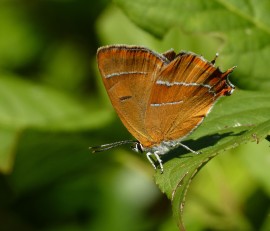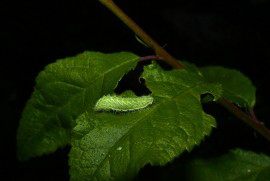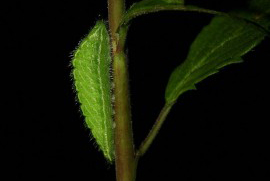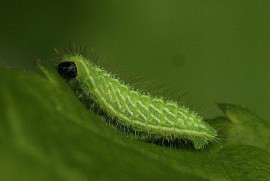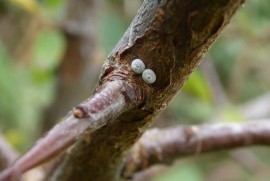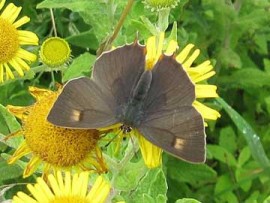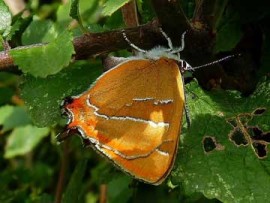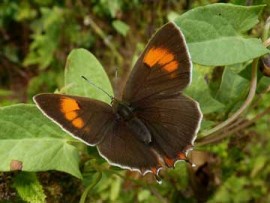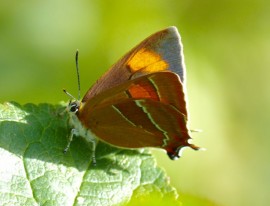by Richard Roebuck
The Brown Hairstreak is our largest hairstreak species. It's very beautiful but very elusive. The males and females are slightly different in coloration - indeed they were once thought to be different species.
West Sussex is a stronghold for this species and the adults are on the wing from late July. It is often seen by chance but it is also a challenge for the enthusiast to track down. Observation takes a degree of patience and footwork, but can offer great rewards, as it's a beautiful butterfly. Being elusive it's difficult to determine significant changes in numbers from year to year apart from perhaps by undertaking detailed winter egg counts. The Brown Hairstreak overwinters in the egg stage. Eggs are predominately laid on Blackthorn and also Wild Plum in August and September. On Blackthorn the white pin-sized eggs are relatively easy to see.
They are normally laid singularly but occasional two or more can be seen at the base of young twigs on the bark on protruding Blackthorn shoots or suckering Blackthorn at the base of hedges. They prefer a sheltered site and a sunny south facing aspect, especially if Ash trees are in the vicinity. The eggs hatch in late April or early May to coincide with the opening of buds and leaves on which they feed .The caterpillar is well camouflaged, resembling the underside of a leaf midrib. Although I have seen early instars active in the day, the later instar caterpillars are most active while feeding at night; in the day they can be found at rest by a leaf midrib.
The caterpillars pupate close to the ground in leaf litter in early July and it's believed the pupa is tended by ants. The adults emerge in late July, probably in the early morning, and the males are known to occupy "master trees" where they will fight with each other. I have observed males on the wing patrolling in trees from 7.49am to after 4.00pm in warm conditions. I have also watched males feeding on a secretion from Ash buds, and females are regularly seen nectaring on Brambles, thistles and Fleabane.
It's suspected the males emerge first, followed by the females. Females are generally active after 11.00am when they come down to egg lay but probably cease egg laying around 3.00pm. After mating the female spends time sunbathing which allows the eggs to mature and for this reason can be difficult to spot. However, egg laying is readily observed and is a fascinating spectacle. The female descends a shoot, sometimes spiralling, to find a suitable egg laying location.
In 2000 Neil Hulme discovered an excellent site at Steyning Rifle Range where The Steyning Downland Scheme now maintain a fenced Brown Hairstreak "reserve". Blackthorn and Wild Plum are cut on a rotational basis to provide an ideal egg laying site where young growth, preferred by the Brown Hairstreak, is maintained year on year. There is an annual Brown Hairstreak walk in late August when the Brown Hairstreak can be seen, so long as it's not raining or too windy. They can be seen here and in many other places across West Sussex in warm sunny conditions. The greatest predation is probably of the pupa by small mammals however it is well known that hedge cutting will remove over 95% of eggs laid and is perhaps the greatest annual threat. Brown Hairstreaks live in discreet colonies which can last for many years.
The Brown Hairstreak occurs where there is Blackthorn especially on clay and also chalk but diminishes significantly where there is greensand. It is found up to the Hampshire and Surrey borders but diminishes dramatically to the east of Plumpton / Streat in East Sussex.



